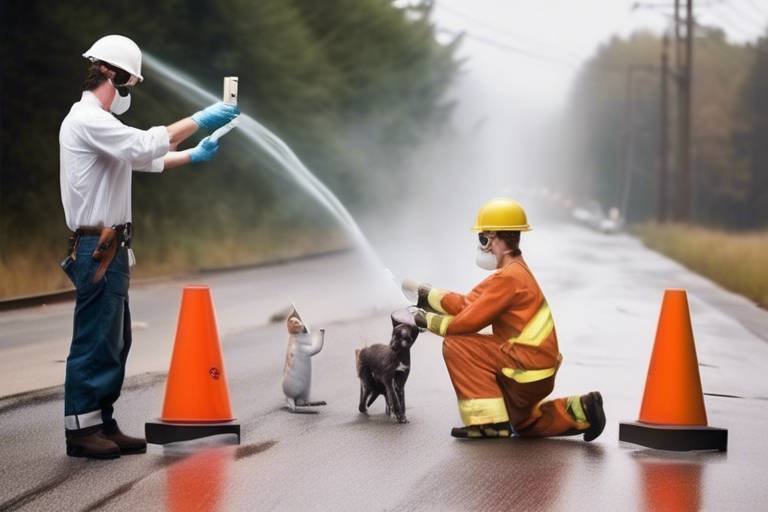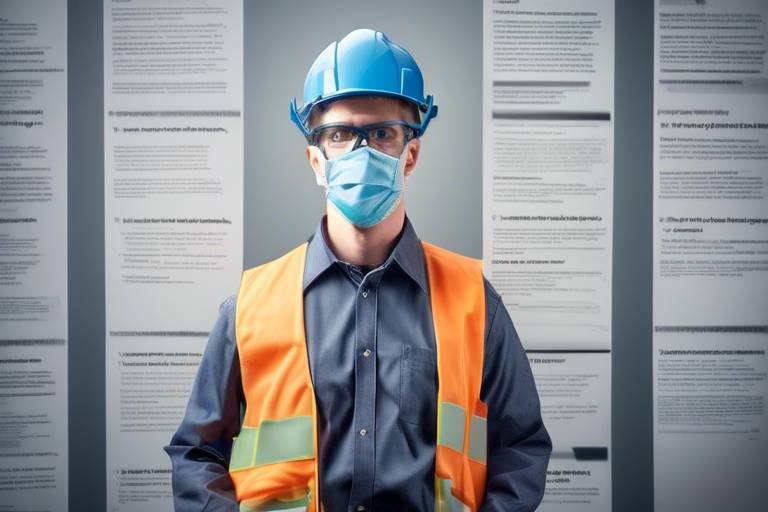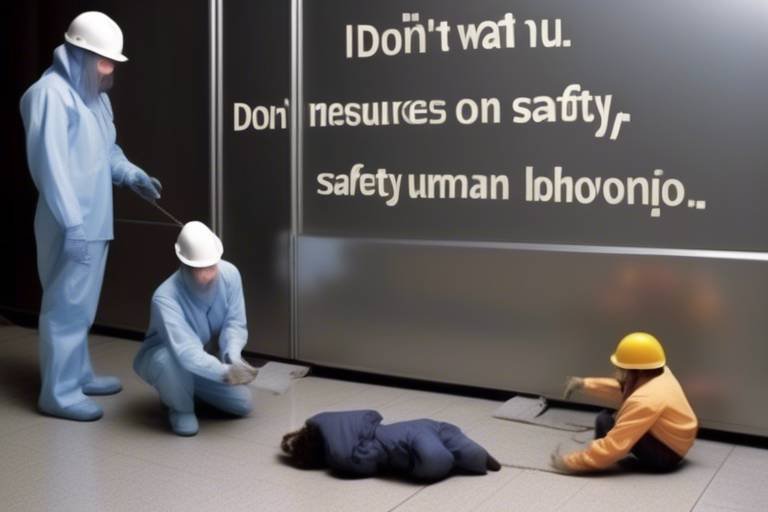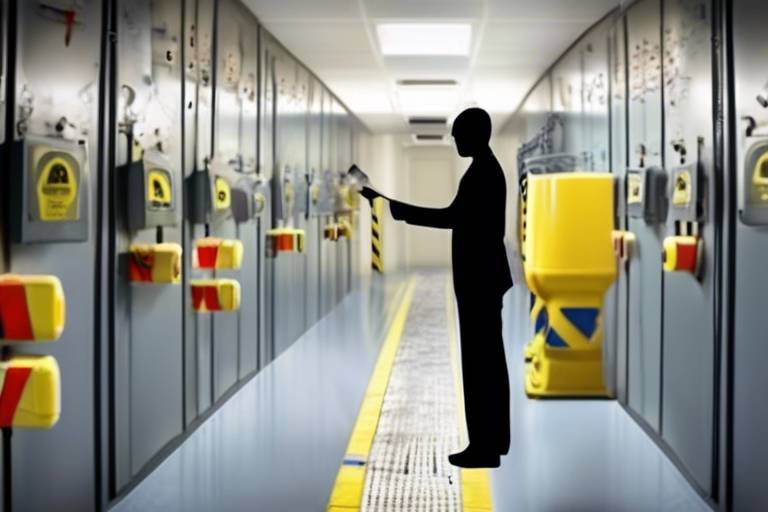Reinforcing Safety Protocols through Human Behavior
In today's world, where safety is paramount, understanding human behavior can significantly enhance safety protocols across various environments. It's fascinating to think about how our actions, decisions, and even our emotions play a crucial role in ensuring safety. Whether in a bustling workplace, a construction site, or a healthcare facility, the way individuals behave directly influences safety outcomes. By focusing on the psychological and social factors that drive human behavior, we can create tailored safety protocols that not only address specific risks but also resonate with the people involved.
Consider this: how often do we overlook safety measures simply because they feel tedious or irrelevant? This is where the magic of understanding behavior comes into play. When safety protocols are designed with human behavior in mind, they become more than just rules; they transform into a culture of safety that everyone actively participates in. This article will delve into the importance of training, communication, and cultivating a safety culture that prioritizes awareness and compliance.
As we explore these concepts, keep in mind that safety is not just about following rules; it's about creating an environment where individuals feel empowered to prioritize their own safety and that of their colleagues. By reinforcing safety protocols through an understanding of human behavior, we can build a more resilient and safety-conscious community.
Understanding human behavior is crucial for developing effective safety protocols. Every day, individuals make choices that can either enhance or compromise safety. For instance, think about how a simple decision to wear a helmet can prevent a serious injury on a construction site. This decision is influenced by a myriad of factors, including personal beliefs, peer pressure, and past experiences. Therefore, it is essential to recognize that behaviors are not isolated incidents; they are part of a larger pattern influenced by the environment and culture.
To effectively address safety challenges, organizations must adopt tailored approaches that consider the unique risks and challenges present in their specific settings. For example, in a manufacturing plant, the focus may be on machinery safety, while in an office environment, ergonomics and fire safety could take precedence. By understanding the behavioral tendencies of employees in these environments, organizations can develop protocols that are not only effective but also embraced by the workforce.
Effective training and education are vital for instilling safety protocols in individuals. When employees are well-informed and equipped with the necessary knowledge, they are more likely to adhere to safety practices. However, traditional training methods often fall short in engaging participants. This is where innovative strategies come into play.
Interactive training methods engage participants more effectively than traditional lectures. Techniques such as simulations and role-playing can significantly improve understanding and application of safety protocols. Imagine a training session where employees participate in a realistic simulation of an emergency situation. This hands-on experience not only enhances retention but also prepares individuals to respond effectively in real-life scenarios.
In our digital age, technology plays a significant role in modern training approaches. The incorporation of virtual reality, e-learning, and mobile apps can reinforce safety protocols and engage learners in ways that traditional methods cannot. For instance, virtual reality allows individuals to experience hazardous situations in a safe environment, making the learning process both immersive and impactful.
Feedback is essential for improving training effectiveness. Regular assessments and participant feedback can refine training programs and ensure ongoing compliance with safety protocols. By fostering a culture of continuous improvement, organizations can adapt their training strategies to meet the evolving needs of their workforce.
A strong safety culture fosters accountability and commitment among employees. Leadership plays a pivotal role in cultivating this culture, as their commitment to safety sets the tone for the entire organization. When leaders prioritize safety, it encourages employees to do the same, creating a ripple effect throughout the organization.
Clear communication is essential for effective safety protocols. It ensures that safety messages are understood and adhered to by all individuals in an organization. Crafting clear and concise safety messages is crucial for comprehension, especially in diverse workplaces where language and cultural differences may exist.
To develop messages that resonate with diverse audiences, organizations should employ techniques that simplify complex information. This can include using visuals, infographics, and straightforward language to convey safety protocols effectively. The goal is to make safety information accessible and engaging for everyone.
Encouraging open dialogue about safety concerns can lead to improved practices. Creating an environment where employees feel comfortable voicing concerns enhances overall safety awareness and compliance. When individuals know their voices matter, they are more likely to participate in safety initiatives and advocate for their own well-being.
Monitoring and evaluation are key to ensuring the effectiveness of safety protocols. Regular assessments and feedback mechanisms are essential to identify areas for improvement and reinforce safe behaviors. By continuously evaluating safety practices, organizations can adapt and refine their protocols to better meet the needs of their employees.
- What is the role of human behavior in safety protocols? Human behavior significantly influences safety outcomes, making it essential to tailor safety protocols to address specific behaviors and challenges.
- How can interactive training improve safety awareness? Interactive training engages participants more effectively, leading to better retention and application of safety practices.
- Why is feedback important in safety training? Feedback helps refine training programs and ensures ongoing compliance with safety protocols, fostering a culture of continuous improvement.
- How can organizations encourage open dialogue about safety? By creating a safe environment where employees feel comfortable voicing concerns, organizations can enhance safety awareness and compliance.

The Importance of Human Behavior in Safety
Understanding human behavior is not just an academic exercise; it’s a critical component in shaping effective safety protocols across various environments. Why is this so important? Well, consider this: every action, from how a worker handles machinery to how a team communicates about potential hazards, is influenced by human behavior. If we want to improve safety outcomes, we must first analyze and understand the underlying behaviors that lead to accidents or near misses.
Every workplace has its unique set of risks and challenges, and human behavior plays a pivotal role in how these are managed. For instance, in a manufacturing setting, a worker's decision to wear protective gear or not can be influenced by their perception of risk, their past experiences, and even the workplace culture. This is why a tailored approach is essential. Safety protocols cannot be one-size-fits-all; they need to adapt to the specific behaviors and attitudes of individuals within the organization.
Moreover, it's important to recognize that behaviors are often shaped by the environment. For example, if an organization prioritizes safety and consistently communicates its importance, employees are more likely to adopt safe practices. On the flip side, a workplace that neglects safety can cultivate a culture where risky behaviors are normalized. This is why we need to pay attention to the interplay between behavior and environment to create a safer workplace.
To illustrate this, consider the following table that highlights key factors influencing human behavior in safety:
| Factor | Description |
|---|---|
| Training | Effective training programs increase awareness and compliance with safety protocols. |
| Communication | Clear and open communication fosters a culture of safety and encourages reporting of unsafe conditions. |
| Leadership | Strong leadership demonstrates a commitment to safety, influencing employee behaviors positively. |
| Environment | A safe and supportive environment encourages employees to prioritize safety in their daily tasks. |
In summary, understanding human behavior is crucial for developing effective safety protocols. It allows us to identify the specific risks associated with different behaviors and tailor our approaches accordingly. By fostering a culture that emphasizes safety, providing comprehensive training, and ensuring clear communication, we can significantly enhance safety outcomes in any environment.

Training and Education Strategies
Effective training and education are the cornerstones of instilling robust safety protocols in any organization. Imagine walking into a workplace where everyone is not only aware of safety procedures but is actively engaged in promoting a safe environment. This vision can become a reality through well-structured training programs tailored to meet the unique needs of each workplace. When employees understand the 'why' behind safety protocols, their compliance naturally increases, creating a safer atmosphere for everyone involved.
To make training impactful, it’s essential to adopt a variety of strategies that cater to different learning styles. People learn differently; some may grasp concepts through visual aids, while others may prefer hands-on experiences. Therefore, integrating a mix of training methods can enhance the overall learning experience. For instance, incorporating interactive training methods such as simulations and role-playing can significantly boost engagement. These techniques allow participants to actively participate in scenarios that mimic real-life situations, making the learning process more relatable and effective.
Interactive training methods are not just buzzwords; they are vital tools in the arsenal of safety training. By moving away from traditional lecture formats, organizations can foster an environment where employees feel more connected to the material. For instance, simulations can immerse participants in realistic situations where they must apply safety protocols, thereby reinforcing their learning. Role-playing allows individuals to step into different shoes, promoting empathy and understanding of various perspectives regarding safety practices.
In today’s digital age, technology plays a pivotal role in enhancing training effectiveness. Imagine being able to practice emergency response procedures in a safe, virtual environment—this is now possible through virtual reality (VR) training programs. VR can simulate hazardous situations without the risks associated with real-life training. Moreover, e-learning modules provide flexibility, allowing employees to learn at their own pace and revisit materials as needed. Mobile apps can also serve as handy tools for quick safety references, making it easier for employees to stay informed about protocols.
Feedback is the lifeblood of any training program. Regular assessments not only measure the effectiveness of the training but also highlight areas for improvement. Engaging participants in feedback sessions can provide valuable insights into what works and what doesn’t. This collaborative approach fosters a culture of continuous improvement, ensuring that safety protocols evolve alongside the changing dynamics of the workplace. By incorporating feedback mechanisms, organizations can refine their training programs, making them more relevant and effective over time.
In conclusion, a comprehensive approach to training and education can significantly enhance safety protocols in any organization. By leveraging interactive methods, embracing technology, and prioritizing feedback, businesses can cultivate a culture of safety that resonates with every employee. Remember, safety is not just a set of rules—it's a mindset that, when nurtured through effective training, can lead to a safer and more productive workplace.

Interactive Training Methods
When it comes to safety training, engaging participants is key. Traditional lectures can feel like a chore, often leading to disengagement and poor retention of crucial information. That’s where come into play. These approaches not only keep participants awake but also actively involve them in the learning process, making safety protocols more memorable and applicable in real-life situations.
Imagine you’re part of a safety training session that feels more like a team-building activity than a dull lecture. This is the essence of interactive training. Techniques such as simulations and role-playing allow participants to experience safety scenarios firsthand. For instance, in a simulated fire drill, employees can practice evacuation procedures in a controlled environment, reinforcing their understanding of what to do in an actual emergency. This hands-on experience can significantly improve their confidence and response times when real situations arise.
Moreover, role-playing exercises can be particularly effective in demonstrating the importance of communication during safety incidents. By acting out various roles, participants can better understand the perspectives of their colleagues, leading to improved teamwork and coordination in times of crisis. It’s like stepping into someone else’s shoes; you gain insights that you might not have considered otherwise.
To illustrate the impact of these methods, let’s consider a quick comparison:
| Training Method | Engagement Level | Retention Rate |
|---|---|---|
| Traditional Lecture | Low | 20% |
| Simulation | High | 75% |
| Role-Playing | High | 70% |
As shown in the table, interactive methods like simulations and role-playing yield significantly higher engagement and retention rates compared to traditional lectures. This is because they tap into the participants' active learning styles, making them feel more involved in the training process.
Another innovative approach to interactive training is the use of gamification. By incorporating game-like elements such as points, badges, and leaderboards into safety training, organizations can motivate employees to participate actively. Gamification not only makes learning fun but also fosters a sense of healthy competition, encouraging employees to strive for excellence in safety practices.
In conclusion, when it comes to reinforcing safety protocols, interactive training methods are not just a trend; they are a necessity. By prioritizing engagement through simulations, role-playing, and gamification, organizations can ensure that their employees are not only informed but also empowered to act safely and responsibly in any situation. After all, safety is a shared responsibility, and equipping everyone with the right tools and knowledge can create a safer workplace for all.
- What are interactive training methods? Interactive training methods involve engaging participants through techniques like simulations, role-playing, and gamification to enhance learning and retention.
- Why are interactive methods more effective than traditional lectures? They actively involve participants, leading to higher engagement and retention rates, which are crucial for understanding safety protocols.
- How can I implement these methods in my organization? Start by incorporating simulations and role-playing into your training sessions, and consider using gamification elements to motivate employees.

Utilizing Technology in Training
In today's fast-paced world, technology has become a game-changer in the realm of training and education, especially when it comes to reinforcing safety protocols. Imagine a scenario where employees can immerse themselves in a virtual environment that mimics real-life situations they may encounter on the job. This is not just a dream; it's a reality thanks to advancements in virtual reality (VR), e-learning platforms, and mobile applications. By leveraging these technologies, organizations can create engaging and effective training programs that resonate with learners.
For instance, VR training allows employees to experience hazardous situations in a safe setting, enabling them to practice their responses without the risk of real-world consequences. This hands-on approach not only enhances understanding but also builds confidence in applying safety protocols. According to recent studies, participants in VR training programs retain information significantly better than those who undergo traditional training methods. This is because they are not just passive recipients of information; they are active participants in their learning journey.
Moreover, e-learning platforms offer flexibility that traditional training methods simply can't match. Employees can access training materials anytime, anywhere, allowing them to learn at their own pace. This is particularly beneficial for organizations with a diverse workforce spread across various locations. By providing a centralized platform for training, companies can ensure that all employees are on the same page regarding safety protocols. Additionally, many e-learning systems come equipped with tracking features that allow managers to monitor progress and identify areas where further support may be needed.
Mobile applications also play a pivotal role in reinforcing safety training. Imagine having a safety manual right in your pocket, accessible with just a few taps. These apps can provide quick access to safety guidelines, emergency procedures, and even interactive quizzes to test knowledge retention. Furthermore, they can send push notifications to remind employees of safety drills or updates to protocols, ensuring that safety remains top of mind.
However, the integration of technology in training is not without challenges. It's vital for organizations to consider the following factors to maximize the effectiveness of their technological training solutions:
- Accessibility: Ensure that all employees have access to the necessary devices and internet connectivity.
- Usability: Training programs should be user-friendly and intuitive to encourage participation.
- Feedback Mechanisms: Incorporate ways for employees to provide feedback on the training experience, allowing for continuous improvement.
In conclusion, utilizing technology in training not only enhances the learning experience but also reinforces the importance of safety protocols in a dynamic and engaging manner. By embracing these advancements, organizations can cultivate a workforce that is well-equipped to handle safety challenges effectively.
Q1: How does virtual reality improve safety training?
A1: Virtual reality provides immersive experiences that allow employees to practice safety protocols in realistic scenarios without the risks associated with real-life situations. This hands-on approach enhances understanding and retention.
Q2: What are the benefits of e-learning for safety training?
A2: E-learning offers flexibility, allowing employees to learn at their own pace and access training materials anytime, anywhere. It also provides tracking features for managers to monitor progress and identify areas needing improvement.
Q3: Are mobile apps effective for reinforcing safety training?
A3: Yes, mobile apps provide quick access to safety guidelines and procedures, making it easier for employees to stay informed. They can also send reminders and interactive quizzes to reinforce learning.

Feedback and Continuous Improvement
Feedback is the lifeblood of any effective training program, especially when it comes to safety protocols. Imagine trying to navigate a maze without ever knowing if you're going the right way; that’s what it feels like without proper feedback. Regular assessments not only help in identifying the areas where individuals excel but also highlight the gaps that need attention. By implementing a structured feedback loop, organizations can foster an environment where continuous improvement becomes the norm rather than the exception.
One of the most effective ways to gather feedback is through surveys and questionnaires. These tools can be designed to capture insights on various aspects of safety training, such as:
- Understanding of safety protocols
- Relevance of training content
- Engagement level during training sessions
- Suggestions for improvement
In addition to surveys, one-on-one interviews or focus groups can provide deeper insights. These interactions allow employees to express their thoughts and experiences in a more personal setting, which can lead to valuable suggestions that might not emerge in a larger group. It's crucial that organizations not only collect this feedback but also act on it. When employees see that their voices matter and that changes are being made based on their input, it cultivates a culture of trust and accountability.
Moreover, continuous improvement should not be a one-time event. It’s an ongoing process that requires regular monitoring and evaluation. Organizations can establish a feedback calendar that outlines when assessments will take place and how feedback will be integrated into future training sessions. This proactive approach ensures that safety protocols evolve alongside the workforce and the challenges they face.
In conclusion, the cycle of feedback and improvement is vital for reinforcing safety protocols. By actively seeking input, responding to concerns, and making necessary adjustments, organizations can create a dynamic training environment that not only meets compliance standards but also genuinely prioritizes the safety and well-being of all employees.
- What is the role of feedback in safety training?
Feedback helps identify strengths and areas for improvement, ensuring that safety protocols are effective and relevant. - How can organizations gather feedback?
Organizations can use surveys, one-on-one interviews, and focus groups to collect valuable insights from employees. - Is feedback a one-time process?
No, feedback should be an ongoing process that continuously informs and improves safety training programs. - Why is employee involvement important in safety protocols?
Employee involvement fosters a culture of trust and accountability, making it more likely that safety protocols will be adhered to.

Building a Safety Culture
Creating a robust safety culture within an organization is not just a checkbox on a compliance list; it’s a fundamental shift in how everyone views safety. Imagine a workplace where safety is as ingrained in the daily routine as checking emails or attending meetings. This transformation requires commitment from all levels of the organization, starting with leadership. When leaders prioritize safety, it sends a clear message that safety is a core value, not merely a guideline. This commitment fosters a sense of accountability among employees, encouraging them to take ownership of their safety practices.
Moreover, effective communication plays a pivotal role in building this culture. It’s essential for leaders to communicate their expectations clearly and consistently. When safety messages are conveyed in a straightforward manner, employees are more likely to understand and adhere to them. For instance, consider the following key aspects of communication in a safety culture:
- Transparency: Sharing information about incidents and near misses can help everyone learn from mistakes.
- Inclusivity: Involving employees in safety discussions ensures that everyone feels valued and heard.
- Regular Updates: Frequent communication about safety protocols keeps the importance of safety at the forefront of everyone's mind.
Furthermore, employee involvement is crucial in cultivating a safety culture. When employees are actively engaged in safety initiatives, they feel empowered and responsible for their own safety as well as that of their colleagues. This can be achieved through various means, such as:
- Safety committees that include representatives from different departments.
- Regular safety drills that allow employees to practice and refine their responses to emergencies.
- Encouraging suggestions for safety improvements from all staff members.
To solidify this culture, organizations should also implement recognition programs that celebrate safety achievements. Recognizing individuals or teams who consistently adhere to safety protocols can motivate others to follow suit. It’s all about creating a positive feedback loop where safety is not just enforced but embraced.
In conclusion, building a safety culture is an ongoing process that requires dedication, clear communication, and active participation from everyone in the organization. It’s about creating an environment where safety is prioritized, understood, and practiced daily. By fostering this culture, organizations can significantly reduce incidents and enhance overall well-being, making the workplace a safer and more productive environment for all.
Q1: What is a safety culture?
A safety culture refers to the shared values, beliefs, and behaviors regarding safety within an organization. It emphasizes the importance of safety in everyday operations and encourages proactive measures to prevent accidents.
Q2: Why is leadership important in building a safety culture?
Leadership is crucial because it sets the tone for the entire organization. When leaders prioritize safety, it encourages employees to do the same, creating a collective commitment to safe practices.
Q3: How can employees contribute to a safety culture?
Employees can contribute by participating in safety discussions, providing feedback, and actively engaging in safety initiatives. Their involvement is vital for creating a culture of safety.
Q4: What role does communication play in safety culture?
Effective communication ensures that safety messages are understood and adhered to by everyone. It fosters transparency, inclusivity, and regular updates about safety practices.
Q5: How can organizations recognize safety achievements?
Organizations can implement recognition programs that celebrate individuals or teams who demonstrate a commitment to safety, thereby motivating others to prioritize safety in their daily routines.

Effective Communication Strategies
Clear communication is the backbone of effective safety protocols. Imagine trying to navigate a maze without a map; that's how employees feel when safety messages are unclear or convoluted. When safety instructions are communicated poorly, the risk of accidents increases dramatically. Therefore, it’s vital to ensure that every safety message is not just heard but understood. This involves tailoring communication strategies to fit the unique needs of different teams and individuals within the organization.
One of the most effective ways to enhance communication is through the use of visual aids. Charts, infographics, and videos can convey complex safety information in a digestible format. For instance, a simple infographic illustrating the steps for emergency evacuation can be more effective than a lengthy manual. Additionally, utilizing real-life examples during safety briefings can make the information relatable and memorable. When employees see how safety protocols apply to their daily tasks, they are more likely to adhere to them.
Another key aspect of effective communication is the development of clear safety messages. Crafting messages that are concise and to the point is crucial. For example, instead of saying, "Please ensure you wear your personal protective equipment at all times while on the job site," a clearer message could be, "Always wear your hard hat and gloves on the job site." This straightforward approach minimizes confusion and reinforces the importance of compliance.
Moreover, fostering an environment that encourages open dialogue about safety concerns is essential. Employees should feel comfortable voicing their worries without fear of repercussions. This can be achieved through regular safety meetings where team members can discuss challenges and share ideas for improvement. When employees know their input is valued, they become more engaged in safety practices. Consider implementing a suggestion box or a digital platform where employees can anonymously submit their safety concerns and suggestions.
To illustrate the importance of communication in safety protocols, here's a simple table that outlines the key elements of effective communication strategies:
| Communication Element | Description |
|---|---|
| Clarity | Messages should be straightforward and easy to understand. |
| Visual Aids | Use infographics and videos to enhance comprehension. |
| Real-Life Examples | Incorporate relatable scenarios to illustrate safety protocols. |
| Open Dialogue | Create a culture where employees can voice safety concerns freely. |
In conclusion, effective communication strategies are paramount in ensuring that safety protocols are not only understood but also embraced by all employees. By focusing on clarity, utilizing visual aids, sharing real-life examples, and encouraging open dialogue, organizations can create a safer work environment. Remember, safety is not just a set of rules; it’s a culture that thrives on clear communication and active participation from everyone involved.
- What are the key components of effective safety communication? Effective safety communication includes clarity, the use of visual aids, real-life examples, and fostering open dialogue.
- How can I encourage employees to voice their safety concerns? Create a safe environment for discussion, hold regular meetings, and consider anonymous feedback options.
- Why is visual communication important in safety protocols? Visual aids simplify complex information, making it easier for employees to understand and remember safety procedures.

Creating Clear Safety Messages
When it comes to safety protocols, clarity is king. Crafting clear and concise safety messages is not just a best practice; it's a necessity. Think about it: if a safety message is muddled or overly complex, how can we expect anyone to follow it? It’s like giving someone a treasure map with no landmarks—confusing and ultimately unhelpful. To ensure that safety messages resonate with everyone, we need to focus on a few key strategies.
First and foremost, simplicity is your friend. Use plain language that anyone can understand, regardless of their background or expertise. Avoid jargon and technical terms that might alienate or confuse the audience. For example, instead of saying "utilize personal protective equipment," simply say "wear safety gear." This small change can make a world of difference in comprehension.
Another vital aspect is to tailor your messages to your audience. Different groups may have varying levels of understanding or concern regarding safety issues. For instance, a construction worker might require different safety instructions than an office employee. By considering the specific context and needs of your audience, you can create messages that are not only clear but also relevant. Here’s a quick breakdown of how to tailor messages:
| Audience | Key Focus |
|---|---|
| Construction Workers | Physical safety, equipment usage |
| Office Employees | Ergonomics, fire safety |
| Healthcare Staff | Infection control, emergency protocols |
Visual aids can also significantly enhance the clarity of safety messages. Using icons, infographics, and diagrams can help convey complex information in a more digestible format. For instance, a simple infographic illustrating the steps to take in case of a fire can be far more effective than a lengthy written protocol. People often remember images better than words, so leverage this to your advantage.
Finally, it’s essential to test your messages for understanding. This can be done through surveys or informal discussions. Ask employees to paraphrase the safety message in their own words. If they struggle, it’s a sign that the message needs to be revised. Regularly revisiting and updating safety messages ensures they remain relevant and effective.
In conclusion, creating clear safety messages is not just about what you say, but how you say it. By focusing on simplicity, tailoring messages to your audience, utilizing visual aids, and testing for understanding, you can significantly enhance safety compliance and awareness within your organization. Remember, a well-understood safety message can be the difference between a safe workplace and one fraught with risk.
- Why is clarity important in safety messages?
Clarity ensures that everyone understands the safety protocols, reducing the risk of accidents and misunderstandings. - How can I tailor safety messages for different audiences?
Consider the specific roles and responsibilities of each group and adjust the language and content accordingly. - What role do visual aids play in safety communication?
Visual aids help to simplify complex information and make it easier to remember, enhancing overall understanding. - How often should safety messages be reviewed?
Regular reviews, at least annually or whenever procedures change, help keep safety messages relevant and effective.

Encouraging Open Dialogue
When it comes to safety in the workplace, one of the most powerful tools we have at our disposal is open dialogue. Encouraging employees to voice their safety concerns is not just a nice-to-have; it’s a necessity. Imagine a ship sailing through turbulent waters. If the crew is afraid to speak up about a leak in the hull, the ship is destined to sink. Similarly, in any organization, fostering a culture where employees feel comfortable discussing safety issues can prevent accidents and enhance overall compliance.
Creating an environment conducive to open dialogue involves a few key strategies. First and foremost, it’s essential to establish trust. Employees must believe that their voices will be heard and that speaking up won’t lead to negative repercussions. This can be achieved through consistent, transparent communication from leadership. When leaders model this behavior, it sets a precedent for the entire organization. For instance, regular safety meetings can serve as a platform for employees to share their observations and suggestions without fear.
Moreover, utilizing anonymous reporting systems can help bridge the gap for those who might feel uncomfortable speaking out in person. These systems allow employees to report safety concerns confidentially, ensuring that their voices are still heard. However, it’s crucial to follow up on these reports and provide feedback to demonstrate that the organization takes these concerns seriously. A simple acknowledgment that a concern was raised can go a long way in reinforcing the importance of open dialogue.
Additionally, leaders should actively seek feedback during safety training sessions. This can be accomplished through interactive discussions, where employees are encouraged to share their thoughts on safety practices. For example, after a training session, facilitators can ask questions like:
- What safety protocols do you find challenging to follow?
- Can you share an experience where you felt safety was compromised?
- What suggestions do you have for improving our safety measures?
These questions not only invite participation but also demonstrate that the organization values input from its employees. When people feel that their opinions matter, they are more likely to engage in conversations about safety, leading to a more proactive approach to risk management.
In conclusion, encouraging open dialogue about safety isn't just about keeping lines of communication open; it's about building a culture where safety is everyone's responsibility. By fostering trust, utilizing anonymous reporting systems, and actively seeking feedback, organizations can create an environment where employees feel empowered to speak up. This, in turn, will lead to improved safety practices and a stronger commitment to compliance across the board.
- Why is open dialogue important for safety?
Open dialogue allows employees to voice concerns and share insights, leading to improved safety practices and reduced risks. - How can leaders encourage open dialogue?
Leaders can encourage open dialogue by fostering trust, providing anonymous reporting options, and actively seeking feedback from employees. - What role does feedback play in safety culture?
Feedback reinforces the importance of safety and shows employees that their concerns are taken seriously, enhancing overall compliance.
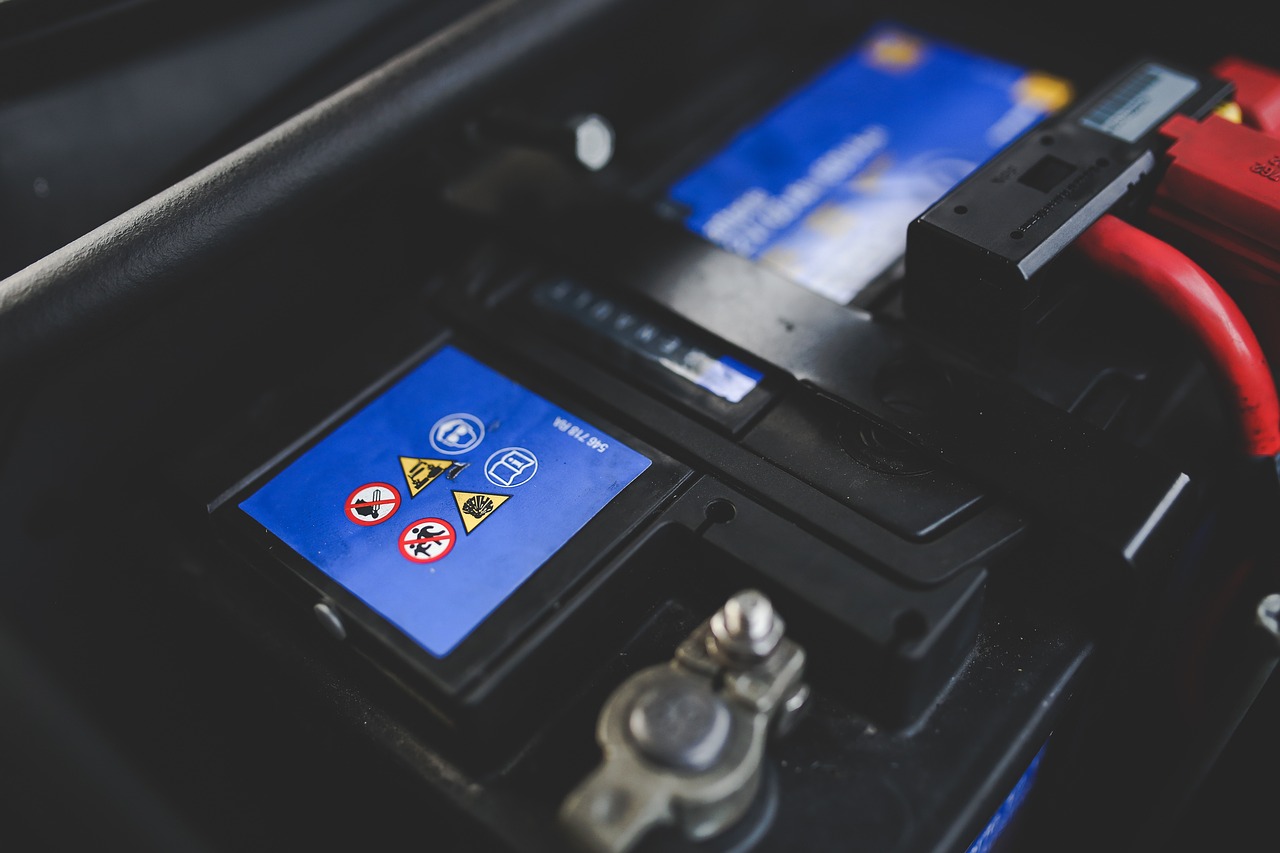
Monitoring and Evaluating Safety Protocols
Monitoring and evaluating safety protocols is not just a checkbox exercise; it's a critical component of any effective safety management system. Think of it as the heartbeat of your safety culture—without it, you're just going through the motions. Regular assessments allow organizations to identify weaknesses in their safety practices, ensuring that employees are not only following protocols but also understanding their importance. The goal here is to create a dynamic system that adapts to changing circumstances and emerging risks.
One of the most effective ways to monitor safety protocols is through regular audits. These audits can be conducted internally or by third-party experts who can provide an unbiased perspective. During these audits, various aspects of safety protocols are evaluated, including compliance with regulations, effectiveness of training programs, and the overall safety culture within the organization. The insights gained can be invaluable for making informed decisions about necessary changes.
Moreover, feedback mechanisms play a pivotal role in the continuous improvement of safety protocols. Organizations should encourage employees to share their experiences and suggestions regarding safety practices. This can be achieved through anonymous surveys, suggestion boxes, or regular safety meetings. When employees feel comfortable voicing their concerns, it leads to a more engaged workforce and a greater sense of ownership over safety practices. To illustrate this, consider the following table that outlines the key components of an effective feedback mechanism:
| Component | Description |
|---|---|
| Anonymous Surveys | Allows employees to provide honest feedback without fear of repercussions. |
| Regular Safety Meetings | Facilitates open discussion about safety concerns and improvements. |
| Suggestion Boxes | Provides a platform for employees to submit ideas for enhancing safety protocols. |
In addition to gathering feedback, organizations should implement a system for tracking safety incidents and near misses. This data is crucial for identifying patterns and areas of concern that may require additional training or changes to existing protocols. For example, if a certain type of incident occurs frequently, it may indicate a need for a targeted training session or a revision of the current safety procedures. By analyzing this data, companies can not only react to issues but also proactively prevent them in the future.
Finally, it's essential to communicate the results of monitoring and evaluation efforts to all employees. Transparency fosters trust and reinforces the importance of safety protocols. When employees see that their feedback leads to tangible changes, it enhances their commitment to safety practices. So, how can organizations effectively share this information? Regular newsletters, safety bulletins, and team meetings are excellent ways to keep everyone informed about safety updates and improvements.
In summary, monitoring and evaluating safety protocols is an ongoing process that requires commitment from all levels of an organization. By utilizing audits, feedback mechanisms, data analysis, and transparent communication, companies can create a robust safety culture that not only meets compliance standards but also prioritizes the well-being of every employee.
- What is the purpose of monitoring safety protocols? Monitoring safety protocols helps identify weaknesses, ensures compliance, and fosters a culture of continuous improvement.
- How often should safety audits be conducted? Safety audits should be conducted regularly, at least annually, or more frequently if there are significant changes in operations or regulations.
- What role does employee feedback play in safety evaluation? Employee feedback is crucial for identifying areas for improvement and enhancing engagement in safety practices.
- How can organizations effectively communicate safety updates? Organizations can use newsletters, safety bulletins, and team meetings to share important safety information with employees.
Frequently Asked Questions
- Why is understanding human behavior important for safety protocols?
Understanding human behavior is crucial because it directly influences how safety protocols are followed. When we grasp the reasons behind certain behaviors, we can tailor our safety measures to address specific risks and challenges effectively. It’s like knowing the playbook before stepping onto the field; it helps everyone play their part in maintaining safety.
- What are some effective training methods for promoting safety?
Effective training methods include interactive techniques like simulations and role-playing. These methods engage participants more than traditional lectures, making the learning experience memorable. Think of it as learning to ride a bike; you need to practice balancing and pedaling, not just read about it!
- How does technology enhance safety training?
Technology enhances safety training through tools like virtual reality, e-learning platforms, and mobile apps. These innovations provide immersive experiences that can simulate real-life scenarios, making it easier for learners to understand and apply safety protocols. It’s like having a personal trainer who can guide you through every step, ensuring you’re prepared for any situation.
- What role does feedback play in safety training?
Feedback is essential for continuous improvement in safety training. Regular assessments and participant input help refine training programs, ensuring they remain effective and relevant. It’s similar to tuning a musical instrument; without feedback, you might miss that off-key note that needs adjusting!
- How can organizations build a strong safety culture?
A strong safety culture can be built through leadership commitment, clear communication, and active employee involvement. When everyone feels accountable for safety, it transforms into a shared value rather than just a set of rules. It’s like being part of a team where everyone plays their position to win the game!
- What are some effective communication strategies for safety protocols?
Effective communication strategies include crafting clear and concise safety messages and encouraging open dialogue about safety concerns. Clear messages ensure that everyone understands the protocols, while open dialogue creates an environment where employees feel comfortable sharing concerns. It’s like having a conversation with a friend where you both feel heard and understood.
- Why is monitoring and evaluating safety protocols important?
Monitoring and evaluating safety protocols are vital to ensure their effectiveness. Regular assessments help identify areas for improvement and reinforce safe behaviors. Think of it as checking your GPS before a road trip; you want to make sure you’re on the right path and adjust if necessary!

